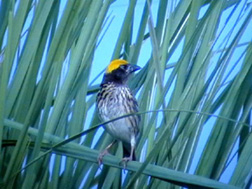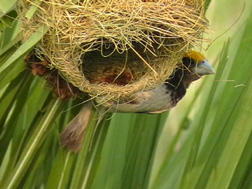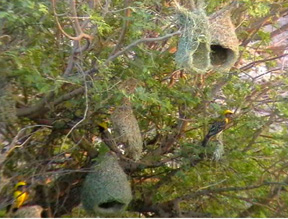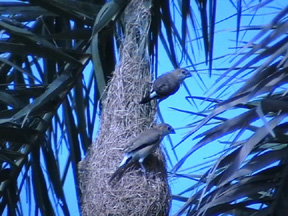A Date with-“ WEAVER”
- Dr. Surya Prakash
I can very well recall when I was in 5th standard in Jodhpur Rajasthan, my father once brought a beautiful, abandoned
nest of a bird which had fallen on the ground due to a sandstorm.
He told me that it is the nest of ‘Baya’. This was the time I realized the value of birds and retain the same passion as on date for my avian friends.
I was also fortunate enough to have grand parents who had great respect for nature.
They taught me some lessons on birds and their relationships with humans and God; an Owl is a vehicle of Goddess of Wealth (Laxmi), Peacock and Swan for Goddess of education
(Saraswati). Garuda giving leads to Rama when Sita was abducted, made a favourite story.
Baya feeding is common in some villages.
‘Julaha” or ‘Baya” or ‘Weaver bird” were the names of the same bird for me until I realized that broadly there are three species
of these ‘Weaver Finches” in NCR region, which were wide spread once upon a time until late eighties in Delhi, But they are now concentrated only at the banks of Yamuna, Sultanpur national Park,(Haryana),
YBDP, OBP, Dadri wetlands(UP) and some near by villages of Delhi.

Baya weaver

Streaked Weaver

Black-breasted weaver
So where have they gone? Why they have gone? Answer is very clear- continuous loss of their habitat in Delhi.
Two common species of this beautiful passerine bird are often seen in Delhi at Yamuna banks; one is ‘Baya Weaver” and second one is
‘Streaked Weaver”.
COMPLETE & INCOMPLETE NESTS OF WEAVERS
In India they breed in summer till the onset of monsoon.
They prefer to build nests on Palm trees, Thorny Acacia nilotica, and other thorny bushes near water bodies where they can find
food which consist of seeds or food grains. Nesting material used is
Elephant grass and Wild grass –Panicum maximum mainly, which grows in wetlands or near water bodies.

Male and female weavers look alike in non-breeding season. Dark brown streak fulvous buff above, plain unstreaked whitish fulvous below, eyebrows long buffy, bill horned
and coloured. During breeding season male changes plumage and puts on a bright yellow crown, dark brown mask, blackish brown bill, upper parts turn dark brown streaked with yellow and yellow breast with cream buff below.
This change of colours makes the male more attractive to female.
Males are also more aggressive to protect their nest from other males.
They now start their main job of nest building, which actually is a deciding factor in propagating their genes to the next generation.
They fly in close formations in groups of 20 to 30 in search of nesting material. It is common to see nests in a group of 20 to 30.on the same tree.
The male uses its strong, rounded bill to tear off 20 to 50 cm of grass blade and weave it on a comfortable place up from the ground
and starts making a hanging nest. Each male makes approximately 450 to 550 trips to the field to fetch grass blades.
In the initial stages nest looks like a ‘Helmet” with a chinstrap. Weavers use their strong bills to weave and knot the strips of grass so that it can sustain strong sand storms and wind velocity.
Now the actual work begins.
Male starts singing melodious songs and displays to attract females. While swinging sitting in an incomplete nest, the male invites females to inspect his handiwork.
An interested female will first inspect the nest by jumping on the helmets and tugging and testing, presumably for strength like a wise housewife before giving approval signals to the owner of the nest. For female the location of the nest is more important
than the nest. This is a crucial time for the male. Once she approves, the nest is immediately completed like an upside down flask featuring central nesting area. This is where the female would lay 3-4 white coloured eggs.
The long tube, which leads to a side entrance, prevents eggs & chicks from predators like snakes.
Female gives the final touches to the nest. Males are the sole in-charge of nest building.
There are many myths associated with the nest that weavers bring fireflies in the nests to light it up etc.
Rejected nests are torn and destroyed by males. In the beginning nest is green but when grass dries it becomes brownish yellow.
Males make several incomplete nests and once the female, after completing mating rituals, is busy incubating eggs, male intelligently
slips to another incomplete nest and again starts courtship displays and songs to attract another female. As they are polygamous, a single male can mate with 2 to 3 females in one breeding season.
It also protects all his nests from other active males. Once the breeding season is over other birds use their abandoned nests.

Indian Silverbill occupying abandoned nest of Weaver
These beauties are now dwindling in
the areas where they used to be seen earlier; like in Ridge forests of Delhi, Sanjay Van,JNU etc. JNU has constructed check dams and has planted elephant grass to re-attract these nature’s architects.
I wish other areas would also be taken care of for the same purpose by society, other wise we will be losing this battle. At some places they are considered to be a pest to the paddy crop hence are scared away and at some places they are used as table
bird they are caught and made into "a succulent dish". So what are you waiting for get up and go to Okhla Bird Park, Yamuna Biodiversity Park, Khadar, Sultanpur National Park, Dadri wet lands etc. to see weavers weaving skills
before its too late.
I am afraid the fate of these lovely birds will be sealed unless we take some action.